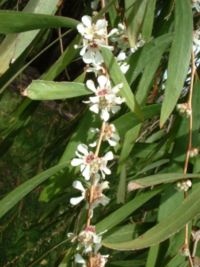Agonis
| Agonis subsp. var. | ||||||||||||||||||||||||||||||||||||||||||||||||||||||||
|---|---|---|---|---|---|---|---|---|---|---|---|---|---|---|---|---|---|---|---|---|---|---|---|---|---|---|---|---|---|---|---|---|---|---|---|---|---|---|---|---|---|---|---|---|---|---|---|---|---|---|---|---|---|---|---|---|

|
|
| ||||||||||||||||||||||||||||||||||||||||||||||||||||||
| ||||||||||||||||||||||||||||||||||||||||||||||||||||||||
- For the genus of moths with this name, see Agonis (moth).
| Agonis secure Fossil range: {{{fossil_range}}}
| ||||||||||||||||||||||||||||||||||||||||||||||||||||||||||||||||||
|---|---|---|---|---|---|---|---|---|---|---|---|---|---|---|---|---|---|---|---|---|---|---|---|---|---|---|---|---|---|---|---|---|---|---|---|---|---|---|---|---|---|---|---|---|---|---|---|---|---|---|---|---|---|---|---|---|---|---|---|---|---|---|---|---|---|---|
 Flowers of A. flexuosa | ||||||||||||||||||||||||||||||||||||||||||||||||||||||||||||||||||
| Plant Info | ||||||||||||||||||||||||||||||||||||||||||||||||||||||||||||||||||
| ||||||||||||||||||||||||||||||||||||||||||||||||||||||||||||||||||
| Scientific classification | ||||||||||||||||||||||||||||||||||||||||||||||||||||||||||||||||||
| ||||||||||||||||||||||||||||||||||||||||||||||||||||||||||||||||||
| [[{{{diversity_link}}}|Diversity]] | ||||||||||||||||||||||||||||||||||||||||||||||||||||||||||||||||||
| {{{diversity}}} | ||||||||||||||||||||||||||||||||||||||||||||||||||||||||||||||||||
| Binomial name | ||||||||||||||||||||||||||||||||||||||||||||||||||||||||||||||||||
| {{{binomial}}} | ||||||||||||||||||||||||||||||||||||||||||||||||||||||||||||||||||
| Trinomial name | ||||||||||||||||||||||||||||||||||||||||||||||||||||||||||||||||||
| {{{trinomial}}} | ||||||||||||||||||||||||||||||||||||||||||||||||||||||||||||||||||
| Type Species | ||||||||||||||||||||||||||||||||||||||||||||||||||||||||||||||||||
| {{{type_species}}} | ||||||||||||||||||||||||||||||||||||||||||||||||||||||||||||||||||
| Species | ||||||||||||||||||||||||||||||||||||||||||||||||||||||||||||||||||
| Agonis baxteri | ||||||||||||||||||||||||||||||||||||||||||||||||||||||||||||||||||
| [[Image:{{{range_map}}}|{{{range_map_width}}}|]] | ||||||||||||||||||||||||||||||||||||||||||||||||||||||||||||||||||
| Synonyms | ||||||||||||||||||||||||||||||||||||||||||||||||||||||||||||||||||
| {{{synonyms}}} |
Agonis is a genus of four species in the plant family Myrtaceae. All are endemic to Western Australia, growing near the coast in the South West corner of the State. Only one, Agonis flexuosa, grows to tree size, the others generally growing as tall shrubs.
Agonis species generally have fibrous brown bark, dull green leaves and inflorescences of small white flowers. They are most readily identified by the powerful odour of peppermint emitted when the leaves are crushed or torn.
Planting Tip: The Agonis flexuosa root ball is very sensitive. Great care must be taken when transplanting to avoid stressing, straining or jarring the area where the trunk meets the root ball.
The name Agonis is from the Greek agon, meaning gathering or collection. It is believed to refer to the tightly clustered inflorescences.
A. flexuosa (Western Australian Peppermint) is easily the most well-known of the Agonis, being a common tree in the parks and road verges of Perth, Western Australia.
The species of Agonis are:
- A. baxteri
- A. flexuosa (Western Australian Peppermint, Swan River Peppermint, Willow Myrtle)
- A. theiformis
- A. undulata
Agonis formerly had a number of other species, but the genus was recently split, with the majority becoming species of Taxandria.
Agonis is the food plant of the moth Aenetus dulcis.
References
- Template:FloraBase
- Boland, D. J. et al. (1984). Forest Trees of Australia (Fourth edition revised and enlarged). Collingwood, Victoria, Australia: CSIRO Publishing. ISBN 0-643-05423-5..
- Blackall, W. E. and Grieve, B. J. (1980). How to Know Western Australian Wildflowers, Part 3A (2nd ed. ed.). Nedlands, Western Australia: University of Western Australia Press. ISBN 0-85564-160-6..
- Powell, Robert (1990). Leaf and Branch: Trees and Tall Shrubs of Perth. Perth, Western Australia: Department of Conservation and Land Management. ISBN 0-7309-3916-2..